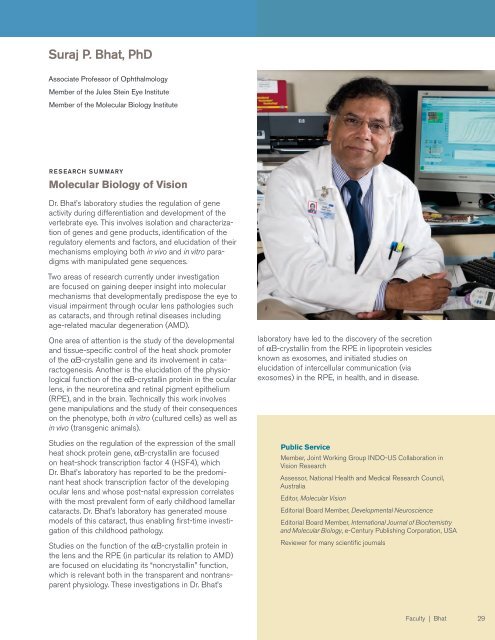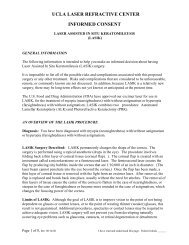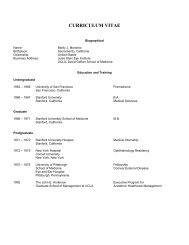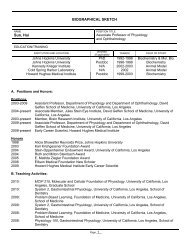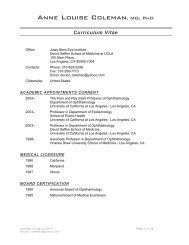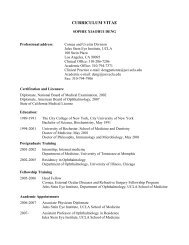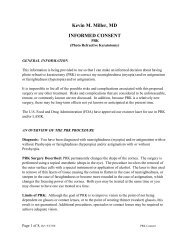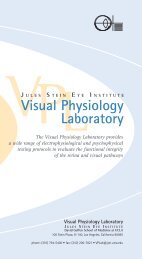View Annual Report - Jules Stein Eye Institute
View Annual Report - Jules Stein Eye Institute
View Annual Report - Jules Stein Eye Institute
Create successful ePaper yourself
Turn your PDF publications into a flip-book with our unique Google optimized e-Paper software.
suraj P. Bhat, PhD<br />
Associate Professor of Ophthalmology<br />
Member of the <strong>Jules</strong> <strong>Stein</strong> <strong>Eye</strong> <strong>Institute</strong><br />
Member of the Molecular Biology <strong>Institute</strong><br />
ReseaRch summaRy<br />
Molecular Biology of Vision<br />
Dr. Bhat’s laboratory studies the regulation of gene<br />
activity during differentiation and development of the<br />
vertebrate eye. This involves isolation and characterization<br />
of genes and gene products, identification of the<br />
regulatory elements and factors, and elucidation of their<br />
mechanisms employing both in vivo and in vitro paradigms<br />
with manipulated gene sequences.<br />
Two areas of research currently under investigation<br />
are focused on gaining deeper insight into molecular<br />
mechanisms that developmentally predispose the eye to<br />
visual impairment through ocular lens pathologies such<br />
as cataracts, and through retinal diseases including<br />
age-related macular degeneration (AMD).<br />
One area of attention is the study of the developmental<br />
and tissue-specific control of the heat shock promoter<br />
of the αB-crystallin gene and its involvement in cataractogenesis.<br />
Another is the elucidation of the physiological<br />
function of the αB-crystallin protein in the ocular<br />
lens, in the neuroretina and retinal pigment epithelium<br />
(RPE), and in the brain. Technically this work involves<br />
gene manipulations and the study of their consequences<br />
on the phenotype, both in vitro (cultured cells) as well as<br />
in vivo (transgenic animals).<br />
Studies on the regulation of the expression of the small<br />
heat shock protein gene, αB-crystallin are focused<br />
on heat-shock transcription factor 4 (HSF4), which<br />
Dr. Bhat’s laboratory has reported to be the predominant<br />
heat shock transcription factor of the developing<br />
ocular lens and whose post-natal expression correlates<br />
with the most prevalent form of early childhood lamellar<br />
cataracts. Dr. Bhat’s laboratory has generated mouse<br />
models of this cataract, thus enabling first-time investigation<br />
of this childhood pathology.<br />
Studies on the function of the αB-crystallin protein in<br />
the lens and the RPE (in particular its relation to AMD)<br />
are focused on elucidating its “noncrystallin” function,<br />
which is relevant both in the transparent and nontransparent<br />
physiology. These investigations in Dr. Bhat’s<br />
laboratory have led to the discovery of the secretion<br />
of αB-crystallin from the RPE in lipoprotein vesicles<br />
known as exosomes, and initiated studies on<br />
elucidation of intercellular communication (via<br />
exosomes) in the RPE, in health, and in disease.<br />
Public Service<br />
Member, Joint Working Group INDO-US Collaboration in<br />
Vision Research<br />
Assessor, National Health and Medical Research Council,<br />
Australia<br />
Editor, Molecular Vision<br />
Editorial Board Member, Developmental Neuroscience<br />
Editorial Board Member, International Journal of Biochemistry<br />
and Molecular Biology, e-Century Publishing Corporation, USA<br />
Reviewer for many scientific journals<br />
Faculty | Bhat 29


